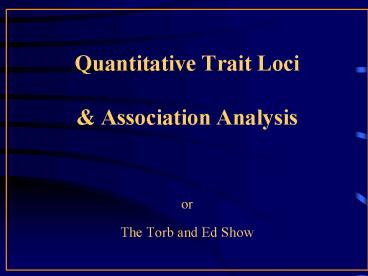Quantitative Trait Loci - PowerPoint PPT Presentation
1 / 35
Title: Quantitative Trait Loci
1
Quantitative Trait Loci Association
AnalysisorThe Torb and Ed Show
2
1. What is quantitative segregation?
3
Typically Maize Geneticists Work with Single
Gene Mutants Cross Wild Type x Mutant
F1Create F2, or BackcrossScore Individual
Plants as Mutant or Wild TypeThen Perform
Linkage Analysis
4
(No Transcript)
5
You Can Just Look at the PlantsScore
as Mutant or Wild TypeDiscrete Classes Now -
Draw Likely Distribution of 100 F2 Plants on
Simple GraphAlbino vs. Green LeavesScore as
Recessive, as Dominant
6
Now, What if Gene Action For Albino was
Additive?Draw The Distributions What if
Gene Action For Albino was Partially Dominant?
7
Y1
Dosage Effects, y1y1y1, y1y1Y1, y1Y1Y1, Y1Y1Y1
8
X
X
Y1 x Y1 (Y1 x Y1)
y1 x Y1
9
(No Transcript)
10
HPLC Chromatogram to Quantify Carotenoids
Can Not Just Visually Score, Need to Measure
11
WHAT ABOUT SCORING THESE?
Requires Near Infrared Reflectance - Protein,
Starch
12
Need to Measure Most Traits of Agronomic
Importance
Or, there may not be a mutant for Your Trait,
but there Are QTL alleles There may be
modifiers Of your mutant Background effect
These are likely QTL
13
2. How do we setup the experiment?
14
For Locus with Quantitative Effects,
You Can Not Just Look at the Plant, You Need to
Measure TraitYou Need Replication Family
Structure (Generally) F23, BC1S1Within Family
VariationLess with Recombinant Inbred Lines
Interaction with Environment
15
We make a cross between two linesSelf or
backcross F1Creates F2, Could GrowF2 are
individual plants Their genotype interacts with
environment phenotypeWhat if one plant grows
where a cow plopped recently more
fertiletaller plant
16
The genotype and environmental effects are
confounded in the phenotype we measure error
We get around this problem by growing
families from each F2 plant,Each F2 plant is
selfed F3 family
17
X
X
Y1 x Y1 (Y1 x Y1)
y1 x Y1
18
Y1
Dosage Effects, y1y1y1, y1y1Y1, y1Y1Y1, Y1Y1Y1
19
X
X
Y1 x Y1 (Y1 x Y1)
y1 x Y1
20
(No Transcript)
21
(No Transcript)
22
By using family structure and replication
You get a more accurate estimate of the
overall genotypic value of that familyOne F2
plant or even one F3 family grown once
Confounded with Environment
23
We Have Genetic SegregationWithin F23
Families 50 of loci segregatingGo to
recombinant inbredsLess than 3 loci
24
We perform linkage analysis just like with
single gene mutants, but we use molecular markers
and measure quantitative phenotypes. Since do
not know where QTL are, Need to map throughout
genome.Three Point Testcross, Try 100 PointSo
need statistical approaches
25
Before Get into Some of this, lets look at
what you eventually get.You get a series of
statistical associations that are represented as
regions throughout the genome
26
3a. What is quantitative trait locus?
27
QTL Positions for Carotenoids One Cross
2.0
5.01
9.01
2.02
04
8.05
3.06
5.05
10.05
4.08
5.07
10.07
2.09
X
VI
VII
VIII
II
III
IV
V
IX
I
28
Two Candidate Genes Map at QTL -Frequently No
Candidate
Genomics Increasing Number Candidate Genes
2.0
5.01
9.01
2.02
Y1
04
ZDS
?
8.05
3.06
5.05
10.05
4.08
5.07
10.07
2.09
Maize Geneticists Clone Characterize These
Genes
X
VI
VII
VIII
II
III
IV
V
IX
I
Y1 Phytoene Synthase ZDS Zeta Carotene
Desaturase
29
3b. How many quantitative trait loci are there?
30
Humans Have Limited Molecular Diversity
0.09
1.34
Silent Diversity (Zhao PNAS 2000)
31
Maize diversity is greater than the difference
between human and chimps
Human diversity about the same as selfing
maize for 4 generations
Silent Diversity (Tenallion et al, PNAS 2001)
32
Measuring Maize Diversity
- Variation is high
- Varies by locus
- Silent best way to comparebetween species
- ? is average pairwise divergence
- ? is based on segregating sites
- ? ? ? ? 4Ne?
33
Natural Maize Diversity
Assumes 2000bp in 1st or 2nd codon positions, and
5000bp of 3rd codon, introns, UTR, promoter
sequence. Based on sample of 32 lines. Data from
Tenaillion et al (2001) and Thornsberry at al 2001
34
The availability of candidate genes creates
exciting opportunities Associative
Analysis Marker Assisted Selection
More Effective and Precise Perform Allele
Searches Better Ones
35
The Availability of Genomic ResourcesCombined
with QTL Mapping DataIs Leading to Gene
DiscoveryBased Initially on Map LocationWhich
Then Creates More Candidate Genes































